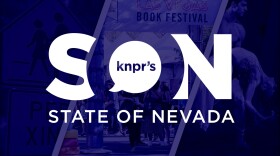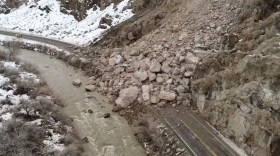Running red lights. Dodging in and out of traffic. Or racing fast ahead—only to get to the next stoplight.
Most people who move here say it: Las Vegas has some of the worst drivers they’ve ever seen.
And a new UNLV study sheds more light. It found that drivers of more expensive cars are less likely to yield to pedestrians in crosswalks.
But as a whole -- nice car or rust-bucket -- drivers in Las Vegas didn’t do that well.
Courtney Coughenour is an assistant professor with UNLV's School of Community Health Sciences.
She helped conduct the study. She said researchers used research assistants dressed exactly the same and walking across the street at the same spot at the same time of day over two weekends to test which drivers would stop for them and which ones would not.
They videotaped the crosswalk and cross-referenced the cars that stopped with the cars that didn't against the cars' Kelley Blue Book value.
"We did find that for every $1,000 increase in the cost of the car, the drivers were 3 percent less likely to yield," she said.
Even more troubling, overall, the study found that only 28 percent of drivers yielded for pedestrians and they were even less likely to yield for walkers who were male and walkers who were black.
"I would say if you're a pedestrian just be careful," she said, "Because it doesn't really matter how much the car costs, if they aren't yielding to you that is probably what's going to matter most for your safety."
While the UNLV study highlights the mistakes drivers make, pedestrians are to blame as well.
Capt. Dan Bledsoe with Las Vegas Metro Police Department said there have 20 pedestrian fatalities so far this year and nine of them can be attributed to pedestrian error.
Bledsoe said everyone who uses the road needs to pay attention - to each other.
"That is definitely important to realize that as we're walking or we're driving we have to pay attention to each other," he said, "One of the key elements we try to tell people is: make eye contact when you're about to cross the street. Simple eye contact might help you."
He said pedestrians believe a driver can see them but they can't and vice versa.
Besides that advice, Bledsoe said it is important for everyone to be more patient when they're driving and to slow down.
Erin Breen is the coordinator for the Traffic Safety Coalition. She has been studying traffic and working to make the roads of Southern Nevada safer for a long time.
She said road users - including drivers, pedestrians, motorcyclists and bicyclists - all need to think about the other users.
"It comes down to people forgetting that they need to be predictable," she said, "If every driver were more predictable, if every road user was more predictable, we would have far fewer crashes."
For Drew Dorian, a staff editor at Car and Driver Magazine, a lot of problems on the road could be alleviated by being more polite.
He created a list of 40 car etiquette rules that he wishes every driver and passenger would follow. His top three included some basics:
"I would be quite happy if other drivers would dim their bright lights for oncoming traffic. Travel at least at the posted speed limit and just use your turn signals."
Dorian believes everyone thinks the drivers in their home state are the worst and we might all be right.
While bad drivers are everywhere, David Swallow, the deputy chief executive officer at the Regional Transportation Commission of Southern Nevada said Las Vegas has some unique challenges.
"One of the things that we have out here is, thankfully, we have a good grid network but we also have long, straight roads that are particularly wide and designed for higher speed travel," Swallow said, "With these big roads, you get big intersections, which requires more timing at the lights, and so, we're able to push through a lot more cars with these longer cycle lengths, but at the same time, people know that there is that inherent time penalty if they don't make the light."
He said people don't want to get trapped waiting for the stoplight to turn green - again - so they run a red light.
Erin Breen, Coordinator, Traffic Safety Coalition; Courtney Coughenour, Assistant Professor, School of Community Health Sciences UNLV; Drew Dorian, Staff Editor, Car and Driver Magazine; Capt. Dan Bledsoe, Traffic Bureau, Las Vegas Metro Police; David Swallow, Deputy Chief Executive Officer, Regional Transportation Commission of Southern Nevada









